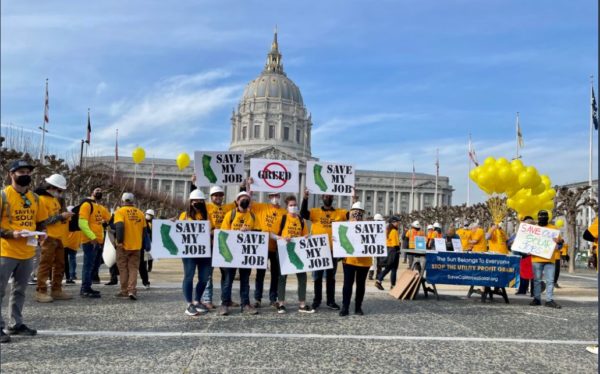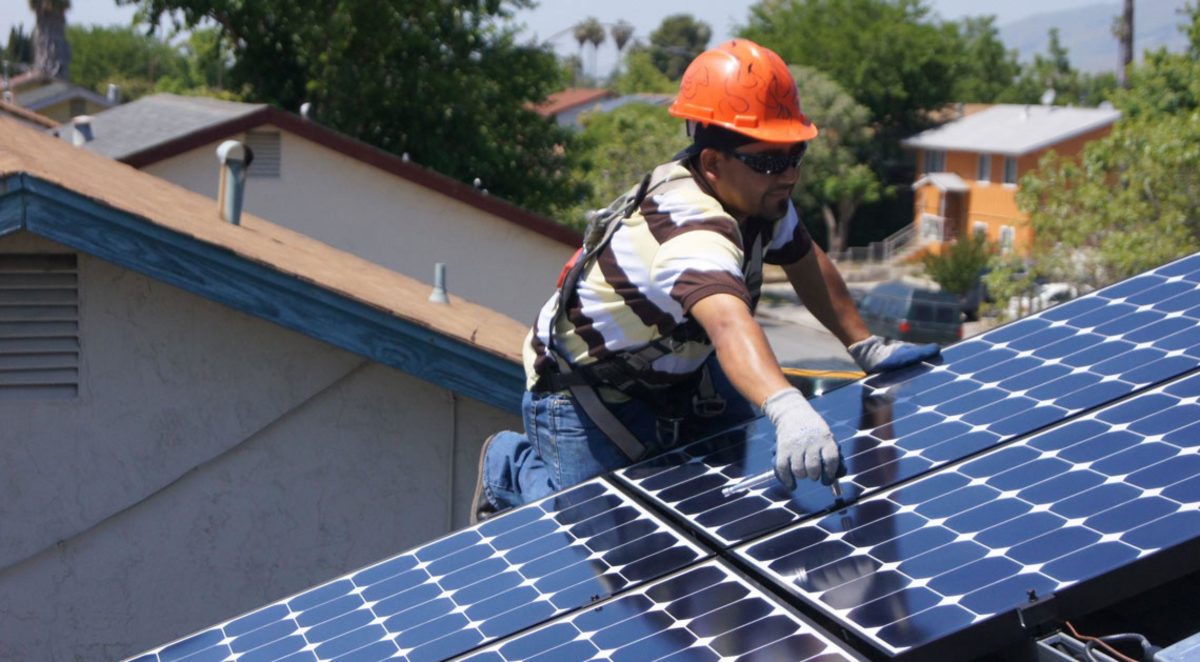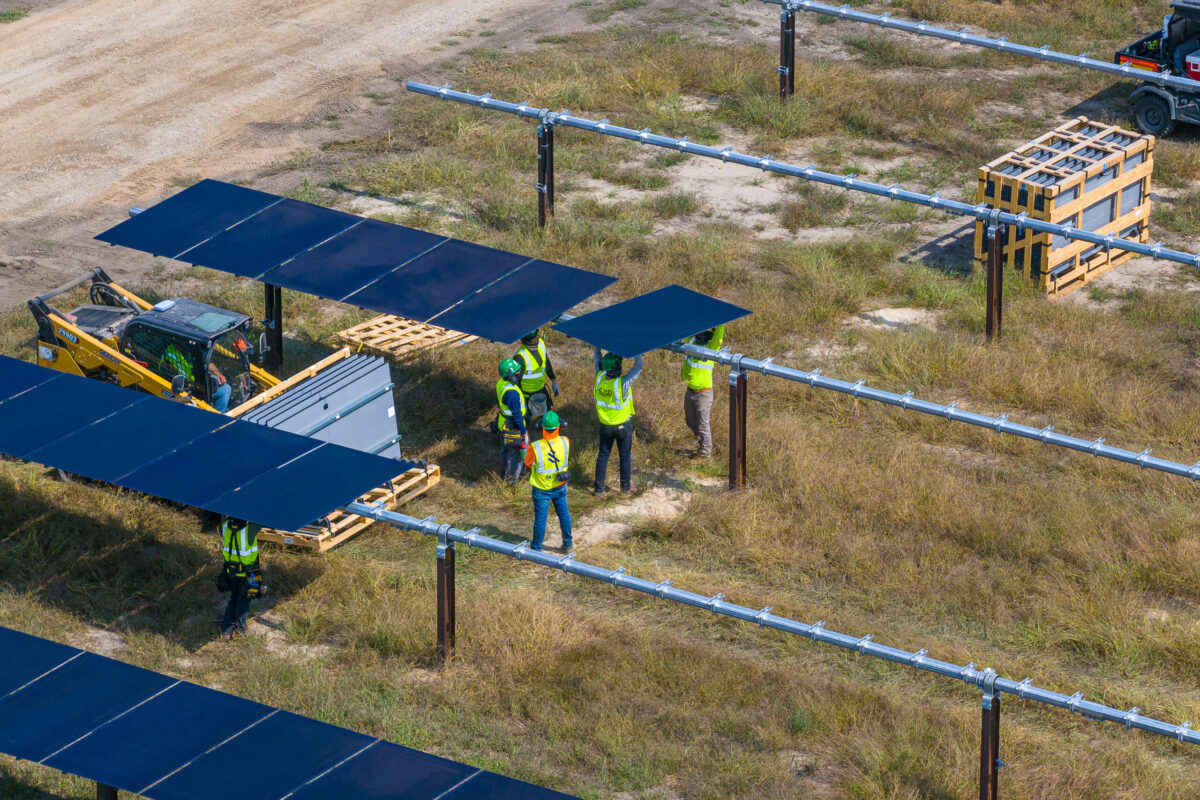A battle over net energy metering (NEM) in the Sunshine State of Florida rages on as legislation introduced late last year is set to dramatically cut the compensation PV owners receive for the excess generation they send to the grid.
Florida SB 1024, introduced by Sen. Jennifer Bradley (R), was filed in November, upending the structure of a 2008 law that supported the nascent stages of the state’s solar industry. Under the 2008 law, residential and commercial customers with systems less than 2MW in capacity are eligible to sell their excess generation back to the utility at the full retail electrical rate on their monthly bill. To calculate a customer’s annual excess generation credit, compensation is based on the avoided cost to the utility for the power it would otherwise have had to generate.

Image: Wikimedia Commons
The new bill calls for a new NEM structure to be submitted by January 1, 2023. The language loosely defines what NEM rates may be, stating it must ensure: “public utility customers owning or leasing renewable generation pay the full cost of electric service and are not subsidized by the public utility’s general body of ratepayers.”
The bill also calls for all energy delivered by customer-owned or leased solar to the public utility to be credited to the customer at the public utility’s full avoided cost, rather than the retail rate.
A third provision said the net metering rule may include fixed charges, including base facilities charges, grid access fees, or minimum monthly bills. This is particularly drawing the ire of solar advocates, who claim it goes directly against the idea of “fairness” that the bill is founded on.
Survey says…
In a recent survey of over 250 active solar shoppers in Florida, solar informational site SolarReviews found 74% of respondents will no longer consider going solar if the proposal passes, and rates are paid on the utility’s avoided cost calculations. If the proposed monthly grid participation is added, 93% of the respondents said they would not buy solar.
Of the bill, Justin Vandenbroeck, president of the Florida Solar Energy Industries Association said that, while the organization is still analyzing the full impact of the legislation, “Initial modeling suggests this legislation has the potential to set the rooftop solar industry back nearly a decade. Erasing the thousands of jobs, consumer choice and savings, along with the resiliency benefits that rooftop solar offers to Floridians.”
Protest planned
A similar proposal was set to be voted upon in California, where grid experts, environmentalists, and industry advocates cast dispersions on NEM 3.0’s proposed fixed charges, calling them a “tax on the sun.” Thousands of Californians held protests, calling for change, and it appears change may occur, as NEM 3.0 was delayed indefinitely.

Image: CALSSA
Now, Floridians brace for a similar fight. Advocacy group Solar United Neighbors is calling for solar supporters to join a planned rally in Tallahassee. The rally is planned for February 8th, 2:30-3:30 p.m.
Cost shift?
This has led utilities to argue that there has been a “cost shift” to non-solar customers. Paying for solar generation results in what the bill calls “increased cross-subsidization of the full cost of electric service onto the public utility’s general body of ratepayers.”
However, today only about 90,000 of the 8.5 million electric customers in Florida are topped with solar. The utility argues that this some 1% of Floridians are creating significant costs for the other 99%.
Lawrence Berkeley National Lab’s sixteen large-scale state-level studies on the cost shift argument that may suggest the bill’s assumptions stand on shaky ground. It found that 40 of the 43 states with net metering programs have a negligible cost increase attributable to solar, and the cost picture remains this way until solar penetration reaches 10% of the state’s total generation.
This content is protected by copyright and may not be reused. If you want to cooperate with us and would like to reuse some of our content, please contact: editors@pv-magazine.com.









Years ago, in 2007, I wondered about how utilities would start to put the squeeze on solar customers. Well, here it is. So, I built my system without a grid tied inverter. I built it with 4 – 3000-watt pure sine wave inverters powering each of 2 circuits each in my house only leaving the 240-volt appliances tied to the grid. Using lead acid deep cycle batteries because lithium batteries were just coming out and were not even made for house powered systems. The system has saved me thousands of dollars so far and it is not subject to the NEM charges or rules. Today, you can go on the Tesla or Sun Run sites and see full blown off grid solutions or hybrid solutions for homes that include power walls and computerized selectable power sharing or back up modes for roof top solar system. If the utility wants to charge you for going solar, just pull the plug on the utility.
Why should solar generators pay more they are forced to stay connected to the grid. I could generate my own power and be more stable than the grid itself but I’m not allowed to disconnect. The power companies that play this game just want the infrastructure from residential without actually paying for it.
Pay? Anyone using solar should be charged a special tax for the destruction of the planet. Did you know if we covered the Sahara desert with solar panels we would boil the planet in one day. So many Geniuses with solar LOL. Tell me how many BTUs of heat does your solar panel system put off. I mean you know how the light sidewalk is cold in the blacktop burns your feet right? Both blacktop highways and solar panels both are warming up the planet. Solar panels aren’t even viable in the Sunshine State let alone any Northern State. Wind and water are the only way to go. And wind really isn’t worth it. It’s a run to the finish line of stupidity. With water power you do not need battery backup or to run diesel generators at night for backup . I’ve even heard morons claiming that they even generate power at night.
Yes, absolutely! And those darn wind generators cause cancer too! It’s just outrageous what they’re doing to us! Do you follow QAnon? You know those liberals aren’t just pushing solar and wind stuff, they’re trafficking in child sex slavery too. I hear they’re using pizza joints as fake store fronts where you can buy children. Next thing you know, they’ll be trying to take away our gas-burning cars so they can replace them with environment-destroying electric cars!
Joe Dirt needs to get his facts strait. Fossil fuel BURNING creates more heat than the solar panels or black top highways both in the heat and what they give off and in the greenhouse gases. Ladies and Gentlemen, this is the mentality we have to deal with when showing the science of global warming and disinformation of the uneducated buy science but educated by conservative talk show hosts who also do not know the science. This is the kind of person that wants to kill rooftop solar and build more fossil fuel power plants instead. he does not even use his real name. Us scientists do. We sign our work.
Lowering electricity bills and saving greenhouse gas emissions by installing PV modules seems like a desirable objective to most of us, but generating home-made electricity inevitably challenges the dominant players of the historically grown electricity market.
For many decades, government regulations have favored and entitled investor-owned utility corporations with guaranteed revenue and a monopolistic, all expenses paid business model. The electricity market in the US is essentially a planned economy immune to competition and run by appointed Utility Commissions. Healthy market mechanisms which would level the playing field between the unequal participants are virtually non-existent.
Some economists have described the existing monolithic market structure as a “natural monopoly”. In the past, there was some truth to the term “natural”, since electricity was generated by a few large power stations and consumed by businesses and residences around the country. Electricity generation, electricity distribution and billing had to be in the hands of one institution due to the available technologies.
New electronic technologies were developed during the past 20 years which enabled decentralized electric power generation, emancipating and enabling former consumers to become prosumers who consume and produce electricity.
For the last 4 decades, allowing the electric meter to run backwards to compensate for the production of home-made electricity was widely accepted as “Net Energy Metering (NEM)” and viewed as a just compensation for the higher ecological value of renewable solar energy produced without greenhouse gas emissions.
Photovoltaic systems used to be very expensive, and only very few pioneers were able to afford distributed PV systems, so this technology never threatened the established business model of one large corporation being in charge of electric power generation, distribution and billing all under one corporate roof, with dedicated, competition free “service areas”.
If the market for gasoline would have exclusive “service territories” for Texaco, Chevron and Exxon, one could imagine the outrage this would cause among local economists. It is therefore bewildering that the electricity market does not need to play by the same economical doctrines based on supply, demand and competition among equal players as any other markets. There is no longer any economic grounds for electricity generation, distribution and billing to be in the hands of one corporate entity. The technical constraints which once existed to justify a monopolistic market structure are now remnants of the past.
Besides a few exceptions, the monolithic market structures of “Grandpa’s Electric Grid” have not evolved with the emerging PV technologies. With the years, the technologies for distributed PV installations have become more and more competitive and the Corporate Utilities have now woken up to see the threat to their established entitlements. Seeing more and more former consumers turn into prosumers has set the corporate utilities on high alert and motivated them to run deceptive political campaigns against the just compensation rates for home-made renewable energy. California is currently debating a punitive tax per installed KW of PV panels and a lower compensation rate for generated solar energy, which would be equal to the avoided fuel cost. (NEM 3.0). Florida Power & Light initiated the introduction of the Bills HB 1024 & HB 714 which would essentially remove the just compensation rate for renewable energy generation and replace this rate with a rate based on the fuel cost avoided by the corporate utilities.
The core of this conflict surrounds a deceptive narrative which derides just compensation rates for renewable energy produced by distributed prosumers as a “cross-subsidy”. The Utilities argue that consumers without renewable production capability would need to shoulder increasing costs of upgrading and operating the electric grid infrastructure.
This deceptive narrative fails for several reasons:
1) Distributed PV systems without backup batteries typically operate with approximately 40% self-consumption rate. Additional backup battery capacity allows distributed PV systems to operate with up to 100% self-consumption rate without causing additional load to the electricity grid. This inevitably leads to the conclusion that ratepayers without PV systems would save money with the increased deployment of distributed PV installations instead of losing money, because distributed PV systems help to avoid costs to upgrade the electric grid.
2) Electric Utilities are entitled to fully offset the costs associated with the construction of their power plants with “capacity charges” automatically paid by the ratepayers. Distributed PV system owners cannot charge other ratepayers for all their expenses related to the installation of their PV systems.
3) Real-Estate costs related to PV installations need to be paid by the homeowners or businesses who install distributed PV systems, while utilities can charge the ratepayers for real-estate purchases associated with solar farms and end up as owners of the lands they purchase with the ratepayer’s money.
4) Utility scale solar farms have other additional cost associated: Whether large swaths of lands are converted from former farm lands used for agriculture or those utility scale solar farms are placed into the formerly untouched nature onto publicly owned lands, the potential destruction of habitat for flora and fauna is an important factor which should be associated with a final price that needs to be paid for carbon neutral electricity generation.
5) Many Utility Scale solar farms in Florida are built on land which is zoned for agricultural use, even though the utilities do not grow any plants for commercial purposes. Residential PV installations are located on residential land which does not benefit from the subsidized property taxes associated with agricultural zoning. Utilities in Florida basically pay a subsidized property tax on only 30% of the actual land value of their solar farms.
6) Corporate Utilities operate their electricity distribution business on publicly owned lands without having to pay a dime for the land use. These corporations owe the general public something in return for their exclusive privileges.
Receiving a just compensation rate for the renewable electricity generated by distributed PV systems is the least we should expect and demand in return.
Excellent explanation. I hope you can get it published by some news outlets.
Thank you Dan. I have published this article on my LinkedIn page.
https://www.linkedin.com/pulse/net-metering-myth-cross-subsidies-achim-ginsberg-klemmt/
Feel free to share it.
Kind regards,
Achim
Again we get crooked politicians on the pay roll. Jennifer should be ashamed of herself for causing the people who voted for her more money to a billion dollar utility company.
It just amazes me that Duke Energy is afraid of the 1% of people who generate their own electricity using solar panels. We live in the Sunshine State and our homes are ideal to take advantage of the Sun’s ability to generate electricity. I don’t know about you but when has Duke Energy upgraded your electrical service for fee. You had 4 price increases last year along and another one this year. Our not used electricity is going back to Duke Energy so they can resell it back to you. This is not costing them a dime. Oh and guess what? They are installing Solar Farms to create electricity and they want you to pay for that cost. Where does this end ?
When all the solar panel systems owners can choose to disconnect from the grid and still provide electricity to the home. Battery based systems can do that now and their cost, including the batteries, still get the Federal tax credits to install even if installed after the original solar panels an add-on.
Solar Companies, that sell rooftop solar, need to sell OFF-GID Systems that power all the home from batteries and panels except the big 240-volt appliances and the one 20-amp garage outlet for the washing machine. Those can still be connected to the grid thus not being totally disconnected would not incur any disconnecting fees or state mandated connection fees or charges. If there is no feedback to the grid, then there is no Net metering. The homeowner just uses less power from the utility and more from the batteries and solar panels. They also need to offer a battery charger that can draw from the grid, like the EV units that charge the EV batteries but use them to charge the home batteries during the cheapest rates on “time of Day” tariffs, as well, or instead of, on the long winter months of little or no sun. Making the batteries the main source of power, for one’s home, is the most climate friendly way to use solar. Running the 240-volt appliances during the lowest cost hours of the day will also save money from the utility and in Tiered usage rates, lowering the total daily usage will also keep the homeowner in the lowest rate tier.
Yes, if the monopolies continue trying to squeeze us, more and more will go with our own off-grid systems. It gets easier and more inexpensive every year. Even the utilities know they can put in solar farms and battery storage and generate electricity cheaper that way now than by building more coal and gas plants. And those of us, who are engineers, can build our own DIY systems for half the usual cost.
Batteries which charge and discharge per time of use windows are already widely used.
Tech will only help better and cheaper
Ten years ago I bought McDonald’s stock. Much better return on investment than solar, even with the subsidies for solar.
Someday solar might be able to survive a level playing field. Till then it will fly on happy thoughts, pixie dust, and subsidies.
In US, it looks like profit can only be made by Corporates, not by Customers or General Public. If any Customers start get profit, the Republicans won’t tolerate, they come up with Snake Oil laws like Energy/Utility Companies Suffer to maintain Grid, blah Blah.
Earlier, Corporates were busy selling their Exorbitant Solar Rooftop Panels at the rate of $8000 per kWh (which you can DIY for just $1000 per kWh).
Even after paying a hefty $8000 per kWh by these CA & FL state Rooftop Customers to Corporates, Customers started getting a meager profit, now the Corporates want a pie on that meager profit too. It is pathetic State of the country almost like a Curse.
Now after getting profits in trillions from Customers thru Rooftop installations, now they turn to get the pie from Customer Rooftop Solar Power generation with snake Oil, NEM 4.0, NM 4 0 kind of snake Oils in Sunshine states like Florida, California.
The main BS for Development is Corporates & Republicans. Both Corporates & Republicans drag the US into backwardness.
Please protest to the hard to eliminate these kind of atrocities by Corporates & Republicans duo & eliminate the new law which is a pure Corporate atrocitiy.